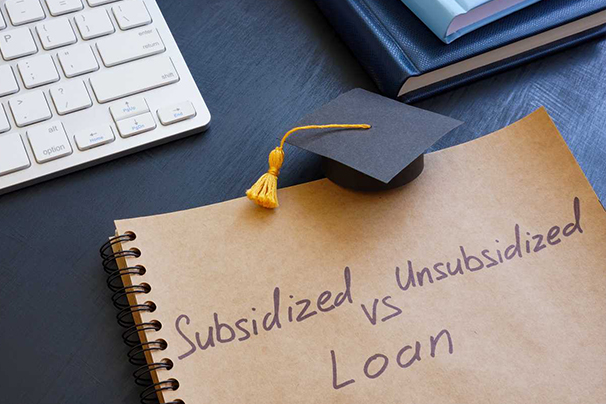Subsidized vs. Unsubsidized Student Loans: Which is Best? When selecting a federal student loan to cover college expenses, you can either choose a subsidized or unsubsidized student loan, depending on which is best for you. The two types of loans provide various advantages, such as good repayment plans, minimal interest rates, loan consolidation, forbearance, and deferment programs.
Furthermore, the main distinction is that subsidized loans are determined by the borrower’s financial needs. Also, the two types of loans require repayment with interest, but the government assists in covering some interest on subsidized student loans. The increase in expenses for college education has encouraged students to borrow to pay for their financial costs.

Some choose loans from private lenders; over 43.4 million borrowers lean towards federal student loans. It’s important to know which alternative among federally subsidized and unsubsidized loans might benefit you to cover college tuition.
Subsidized vs. Unsubsidized Student Loans: Which is Best?
The basic difference between subsidized and unsubsidized loans is as follows: Students engaged in subsidized loans avoid interest under specific conditions. Meanwhile, students with unsubsidized loans don’t obtain breaks, with interest increasing immediately upon loan refunds.
Additionally, among these types of loans, choosing a subsidized student loan is the best option. If you are eligible for a subsidized loan, you will cover less over time compared to an unsubsidized loan.
What is a Subsidized Loan?
A subsidized loan is a form of federal student loan that is accessible only to students who can express their financial needs. To decide on your financial needs, your institution will consider the following factors:
Cost of Attendance (COA)
This provides an approximation of the expenses associated with attending school. The cost of attendance (COA) can differ based on the educational institution and includes estimates for tuition, fees, living expenditures, as well as book and supply costs.
Expected Family Contribution
Your school has numbers to determine the amount of financial aid you qualify for. The Expected Family Contribution (EFC) is calculated considering factors like your parent’s income, your state of residence, household size, and the number of family members attending college. Additionally, EFC remains unchanged regardless of the specific school you attend.
What is an Unsubsidized Loan?
Unsubsidized loans are accessible to graduate, undergraduate, and professional students, irrespective of financial need. Eligibility hinges on your cost of attendance (COA) and the extent of other financial aid you’ve obtained.
Difference Between Subsidized and Unsubsidized Loans
In this section of the article, we will be discussing on Subsidized vs. Unsubsidized Student Loan. The key differences between subsidized and unsubsidized loans are determined by various factors, like who can borrow, eligibility, interest rates, interest paid, loan amount, and repayment.
Subsidized Loan
To qualify for a subsidized student loan, you need to be enrolled in an undergraduate program at least half-time and attend a school in the Direct Loan program. However, eligibility is determined based on demonstrating financial need through cost of attendance (COA) and expected family contribution (EFC).
In addition, the current interest rate for subsidized loans disbursed to undergraduates is 4.99%, with a maximum limit of $23,000. With a subsidized loan, the Department of Education covers the interest under specific terms:
- If you’re enrolled at least half-time.
- Six-month grace period after leaving school.
- During a period of deferment (if you qualify),.
Unsubsidized Loan
Unsubsidized loans are open to undergraduate, graduate, and professional degree students enrolled at least half-time. Your school determines your borrowing limit based on your cost of attendance (COA) and other financial aid you receive.
Furthermore, the current interest rate for undergraduates is 4.99%, and for graduate and professional borrowers, it’s 6.54%. With unsubsidized loans, interest begins accruing as soon as you receive the funds.
If you choose not to make interest payments while in school, the interest increases and is included in the loan total as capitalized interest. Generally, the loan limit for unsubsidized loans is higher than for subsidized student loans.
However, the total loan limits are $31,000, $57,500, and $138,500 for dependent undergraduates, independent undergraduates, and graduate or professional students, respectively.
Who is Eligible For Subsidized or Unsubsidized Loans?
To be eligible for federal direct student loans, either subsidized or unsubsidized, borrowers must meet the following criteria:
- Apply at least half-time at a school participating in the Federal Direct Loan Program.
- Be a U.S. citizen or eligible non-citizen.
- Possess a valid Social Security number (SSN).
- Maintain satisfactory academic progress.
- Hold a high school diploma or its equivalent.
- Have no defaults on any existing federal loans.
Moreover, direct subsidized loans are accessible to undergraduates demonstrating financial need. Both undergraduates and graduate students can obtain direct, unsubsidized loans without any financial need criteria.
If you’re eligible for a subsidized loan, the government covers the loan interest while you’re enrolled at least half-time. Also, this coverage extends during a six-month grace period after leaving school and continues to cover the loan during a period of deferment.
To apply for either loan, you must complete the Free Application for Federal Student Aid (FAFSA). It collects information about your income, assets, and those of your parents.
The school utilizes FAFSA data to determine the types of loans you qualify for and the amount you are eligible to borrow.
Alternatives For Student Loans
If the federal student loans you receive are insufficient to cover your expenses, you have other options to explore.
One alternative is federal parent loans, specifically Direct PLUS loans, for which your parents are responsible for repayment. Additionally, you can consider private student loans as another avenue for financial assistance.
Conclusion
Direct subsidized and unsubsidized loans are both beneficial for covering college expenses. However, both types of loans must require actual repayment with interest.
Carefully consider the amount you need to borrow and assess which repayment option is most suitable for your budget.
